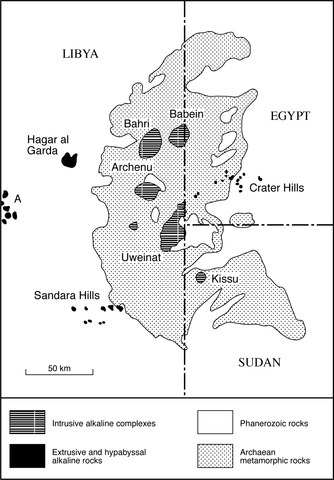stripes
80 km west of Archenu (No. 097-00-012) two circular intrusions of carbonatitic rocks dome gently dipping Cretaceous sandstones and siltstones. The two intrusions are some 5 km apart and both are about 3 km in diameter but dome the associated sediments over 9-10 km. Silicification and ferruginous veining of the sediments extend for up to 2 km from the contact. The more easterly intrusion consists mainly of a syenite containing some nepheline and an apatite-vermiculite rock which is cut by a carbonatite agglomerate. The apatite-vermiculite rock is vertically layered and contains lenses as much as 100x30 m of coarse-grained magnetite rock. The western intrusion consists of carbonatitic vent agglomerates and magnetite rocks with the latter outcropping as an annular zone. In both intrusions the carbonatitic rocks consist of calcite and 'siderite'. A suite of melanephelinites, basanites and carbonatites from ‘plugs and ring complexes’ described by Conticelli et al. (1995) appear to come from this same area and their carbonatites are probably from the two localities described in the ‘Hunting’ Report (1974). A ferrocarbonatite is described as containing ankerite, siderite, amphibole, aegirine and pyrochlore. Rocks described as alkali basalt have pyroxene phenocrysts set in a groundmass of abundant nepheline, opaque minerals, minor pyroxene, mica and plentiful calcite; plagioclase is absent but “round-shaped” feldspar can be found. These rocks would appear to be nephelinites. Nephelinites and basanites have phenocrysts of olivine and minor pyroxene and the former are plagioclase-free and contain nepheline, mica, perovskite, apatite and an opaque phase in the groundmass together with glass. Chemical analyses for most of the mineral phases of these rocks are given by Conticelli et al. (1995) who also give whole rock analyses, including many trace elements and Nd and Sr isotope data.
CONTICELLI, S., MANETTI, P., CAPALDI, G. and POLI, G. 1995. Petrology, mineralogy and isotopes in olivine mela-nephelinites, basanites and carbonatites from Uwaynat region, south east Libya: inferences on their genesis. Africa Geoscience Review, 2: 227-45.HUNTING GEOLOGY and GEOPHYSICS LTD, 1974. Geology of the Jabal Al Uwaynat area, Libyan Arab Republic. Report to Industrial Research Centre, Department of Geological Research and Mining, Tripoli. Boreham Wood, U.K. (unpublished). 156 pp.

